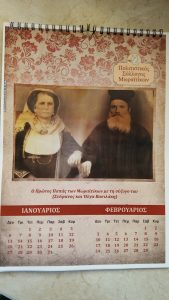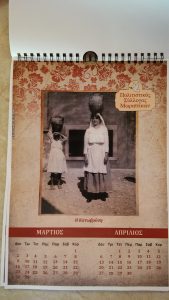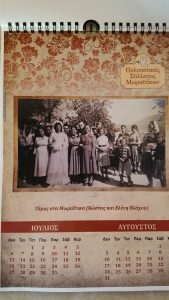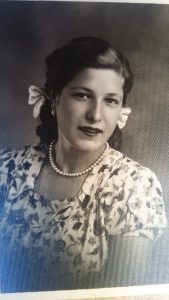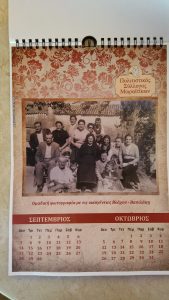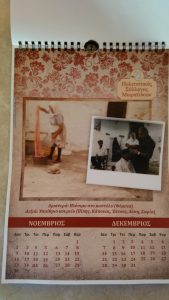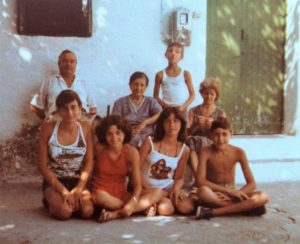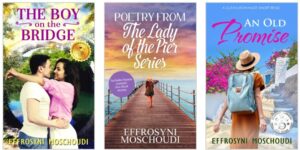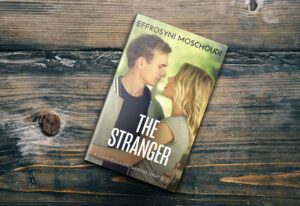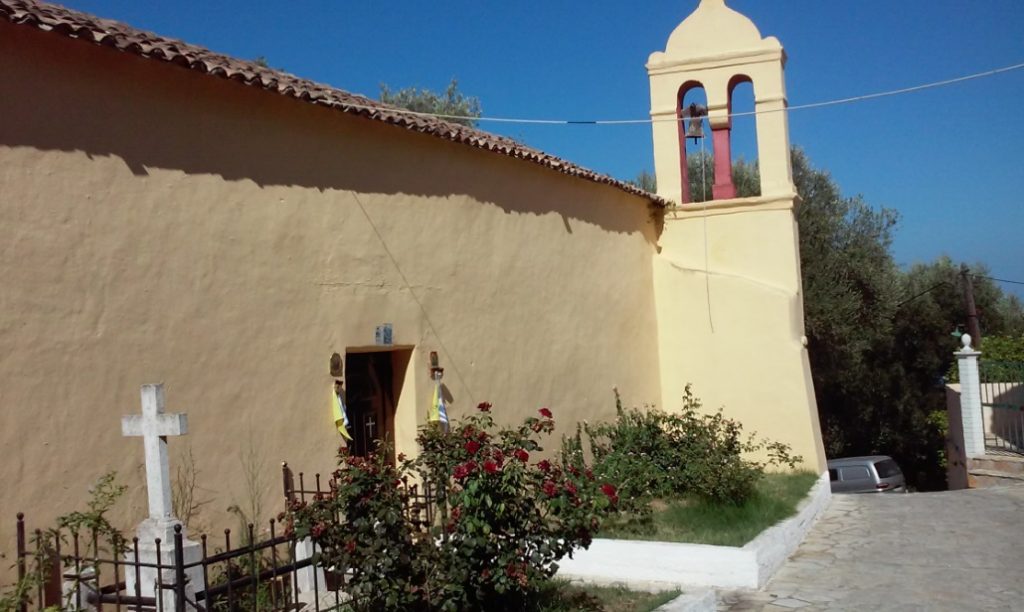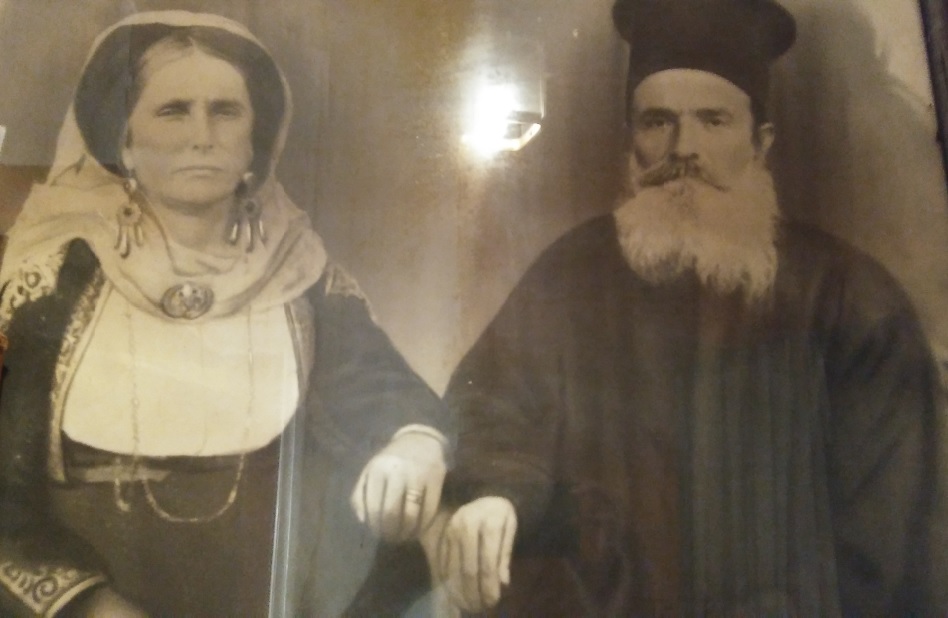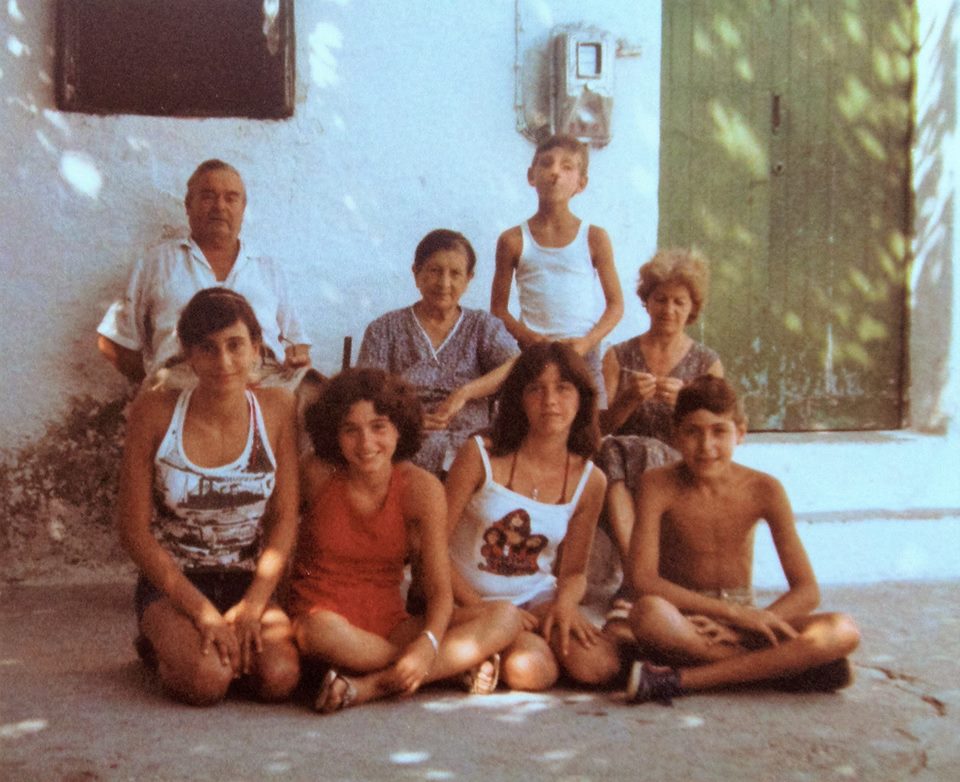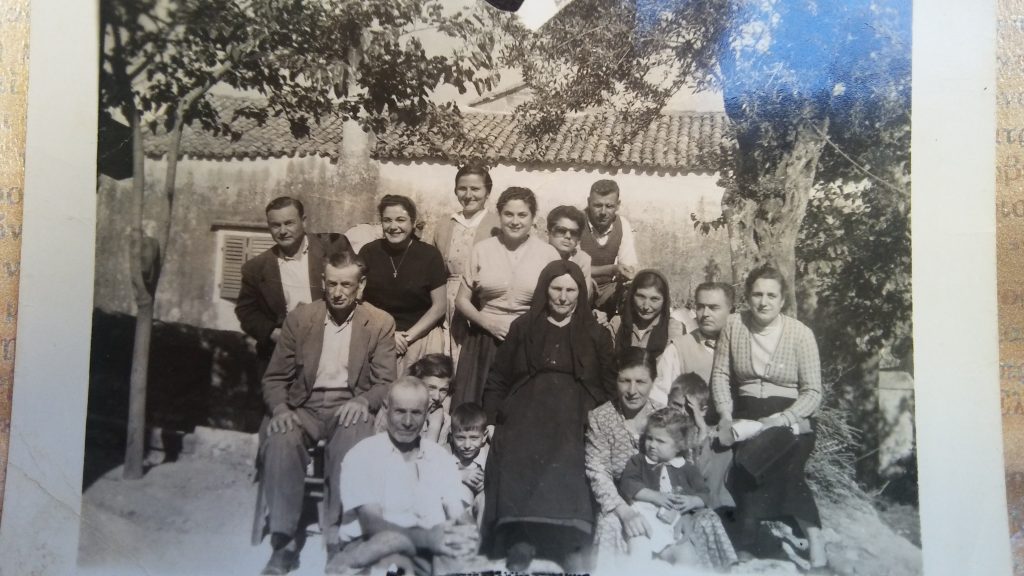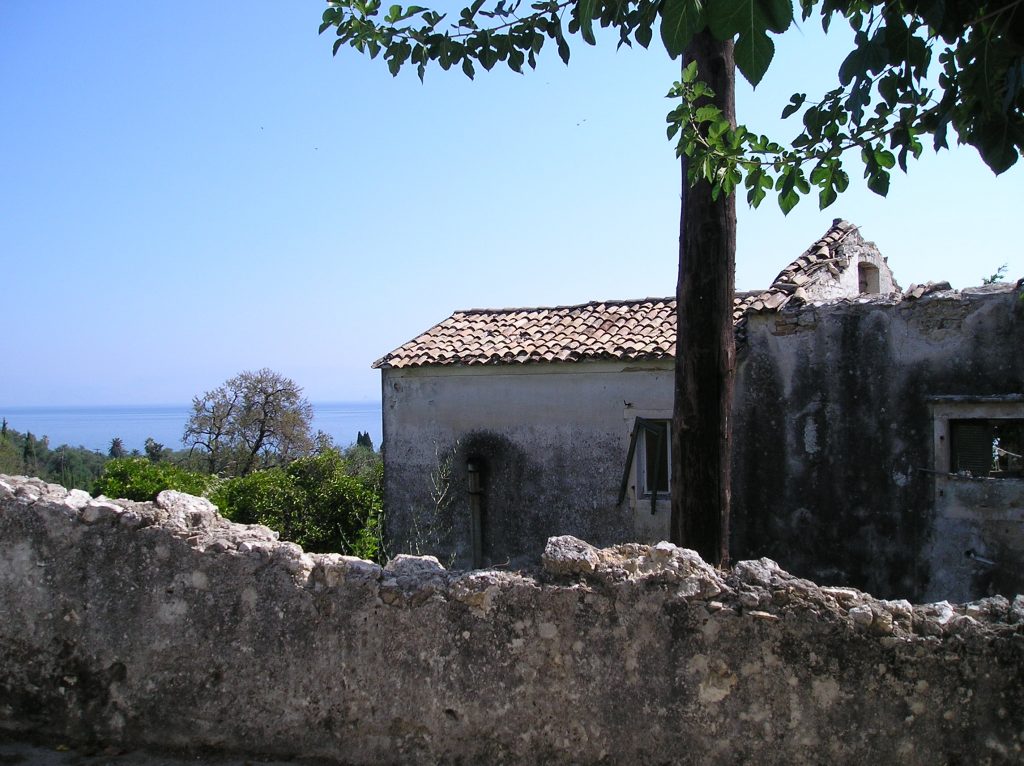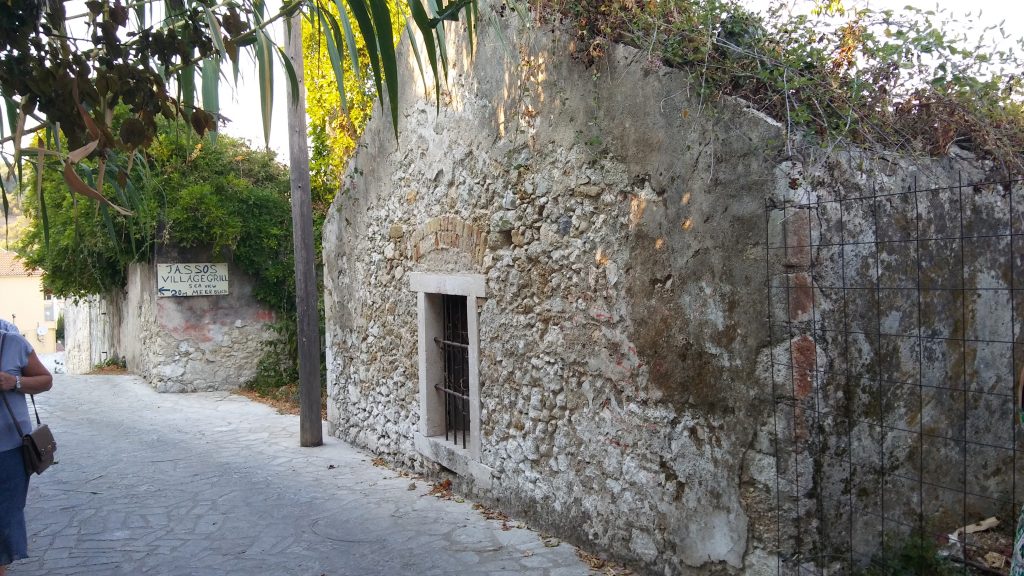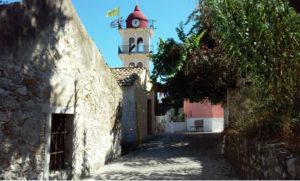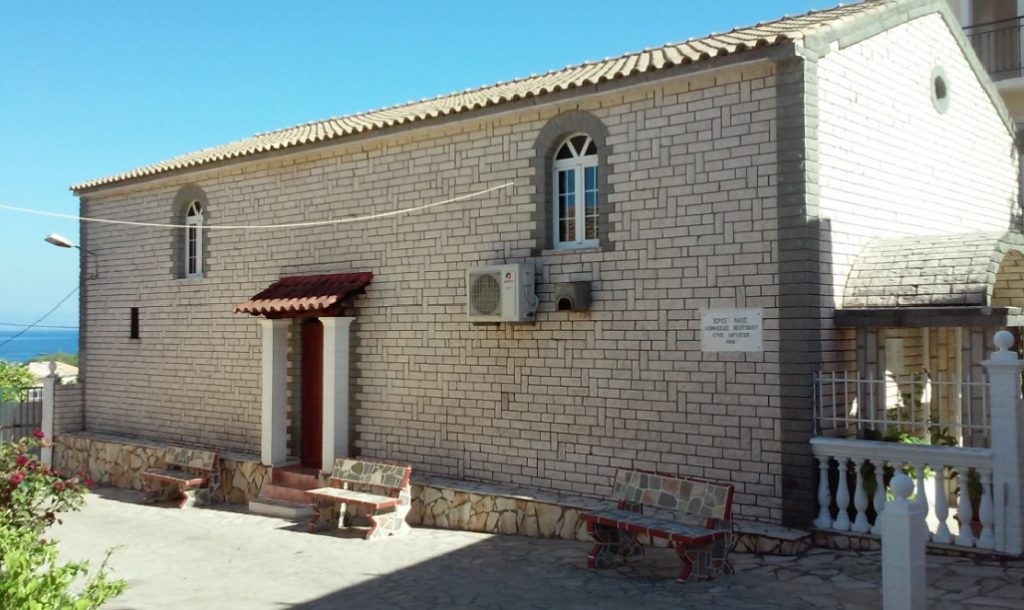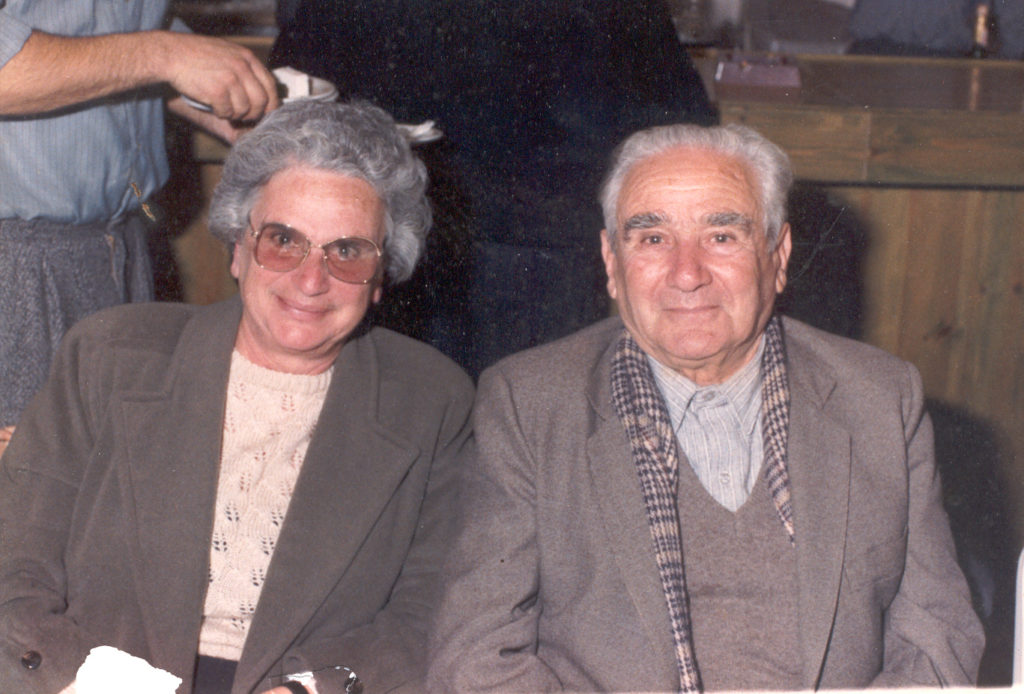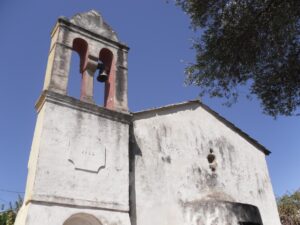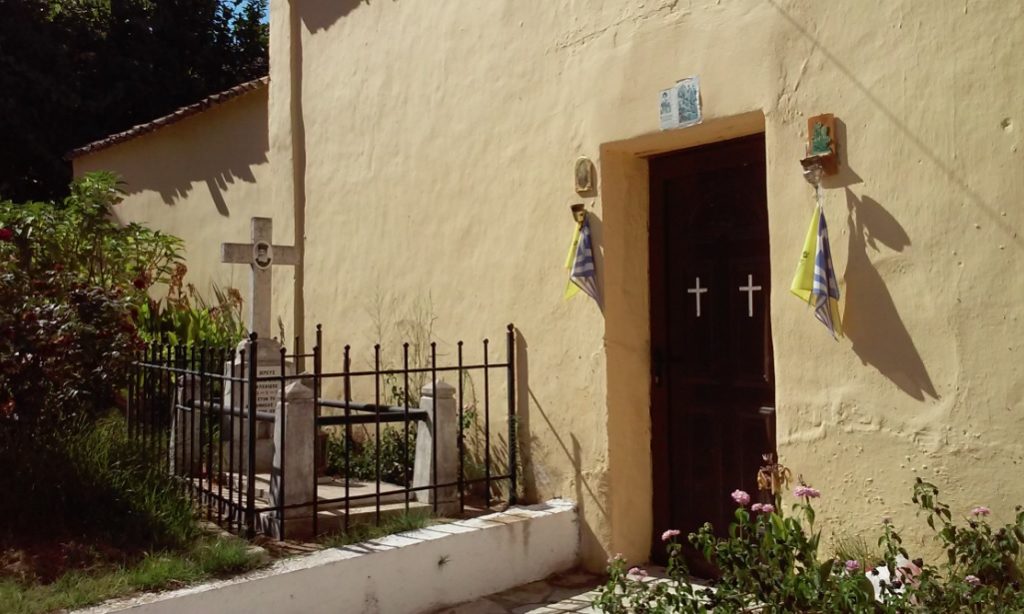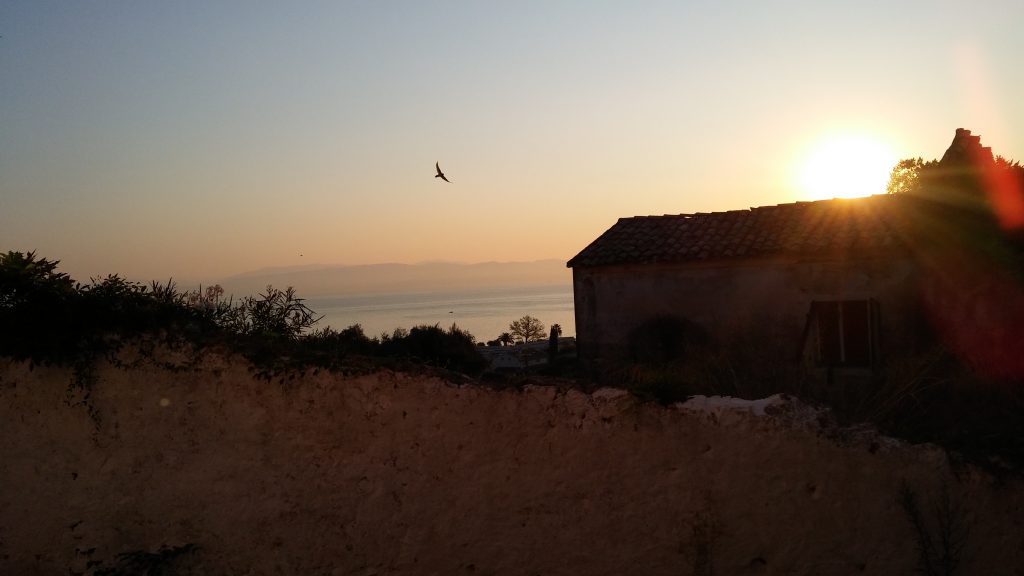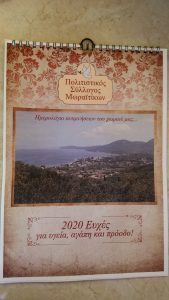
The writing says: Cultural center of Moraitika, a calendar of memories from our village. 2020 wishes for health, love and progress.
Late last year, I was contacted on Facebook by Mrs Aglaia Anthi, President of the cultural center of Moraitika, Corfu. She said she’d seen some old photos on my website and asked for permission to use them for the 2020 calendar of the cultural center. I was thrilled and, of course, I said yes.
Last January, she sent me a copy of this beautiful calendar which I am thrilled to share today. I meant to do it back then but, sadly, I was in a bad place at the time, caught up in my late mother’s daily cancer fight. When I received the calendar, I took it to her bed to leaf through, and she cried to see the photo on the first sheet, which depicted her grandparents, Stefanos and Olga Vassilakis. She kissed their faces on the photograph whispering, ‘i nouna mou, o nounos mou…’ (the Corfiot words for ‘my granny, my granddad). The memory still causes my heart to twinge with feeling. My mother passed away on February 12, and I am comforted to think she is in her grandparents’ and her parents’ arms right now.
Without further ado, here is the calendar, sheet by sheet. I hope you will enjoy it.
January-February. Caption: The first priest of Moraitika and his wife (Stefanos and Olga Vassilakis).
My great-grandfather was also a teacher of Moraitika. The house he built for his family still stands on the hill near the church. Part of it was used as the village school at some point. He is buried in the church yard. For more photos and information, see my post about the two churches of Moraitika on the hill.
March-April. Caption: Kato Vrysi.
Or how the locals pronounce it, ‘Katou Vrysi.’ Loosely translated, it means, ‘The tap downhill’. It is situated on the side of the main road outside the dilapidated estate behind the Coop supermarket. There is also an ‘uphill tap’ called ‘Panou Vrysi’ which is at the edge of the village on the hill under a big plane tree. This is why the locals also call it ‘O Platanos’ (The plane tree). For detailed directions to Panou Vrysi, see my guide to Moraitika.
May-June. Caption: Old estate houses of the village.
The building on the left is the Papadatos estate house. This family also owns the little church of Agios Dimitris nearby (my great-grandfather is buried outside the main door of this church). The building on the right is the Koukouzelis estate house. Today, the grounds are used by the council for cultural events (concerts mainly). For more info and photos, see the same post about the churches.
July-August. Caption: Moraitika wedding of Kostas and Eleni Vlachos.
My uncle Kostas passed away a couple of years ago, but Aunt Leni remains active at her old age (born 1933), and still helps out at her seaside apartments of ‘Nea Zoi’ (beside Caldera on the beach). See my guide to Moraitika for these establishments. Here, below, follows an excellent commentary about this photo by my Aunt Leni as relayed by her daughter-in-law, Spyridoula Vlachos:
‘The wedding took place in 1953 in the village of Episkopiana. This picture was taken at the look out near the St Nikolaos church in Episkopiana that no longer stands. This is the area of the old estate home of Patsos that is now inhabited by the Tata family. After the wedding took place, everyone set off to Moraitika on foot, where the reception party would take place on the village square. On the front, walked the organ players and the priest who held the bible, then followed the bride and the groom, with everyone else behind walking them. Back then, the way to Moraitika was via the estate of the Kapodistrias family. In this photo, Stamatis Vassilakis’s daughter, Marika, is pictured beside the bride dressed in white. She had got married just a week earlier and was pregnant with her first child.’
Re my Aunt Marika (daughter of Great-Uncle Stamatis Vassilakis): She was one of my favourite relatives of the Vassilakis family. She had the heart and the soul of a child. I still recall so vividly the last time I saw her, visiting her in her house after a long while during my short stay in the village. It was a couple of years earlier, just months before she died. She was confused with dementia and didn’t recognize me when I approached her. Still, her good heart must have done, because she kept holding me, her eyes sparkling with love and delight while saying, ‘I love you! I love you!’ I’ll never forget her face that day; so innocent, so loving. Somehow, she is the only one whose name I didn’t have the heart to change in my largely autobiographical novel set in Moraitika, The Ebb.
Back to the wedding photo: Great-Uncle Lilis, a teacher, stands behind Aunt Marika. Behind Aunt Leni, the bride, on the right, is the groom, Uncle Kostas. To his right, stand Aunt Olga, and Great-Uncle Kotsos with Great-Aunt Rini Tsatsanis from Messonghi. The girl with the frizzy hair beside them is Maria, Lefteris Kosmas’s sister (he runs Leftis Romantica). My mother, Ioanna, is pictured further right as a little girl with her hands on her waist.
September-October. Caption: Group photo of members of the Vlachos and Vassilakis family.
My great-grandmother’s maiden name was Vlachos, and her wedding to Stefanos Vassilakis bound the two families together as one with great relations. This photograph was taken outside the Vassilakis house (late 40s to early 50s). She sits at the center dressed in black, as befitted a widow at the time. My great-grandfather passed away in 1944, and she did in 1953. The building shown in the background is the Koukouzelis estate house as mentioned earlier. The mulberry tree they’re sitting under still stands today and so does the olive tree on the right.
Pictured from left to right: Back row: Great-Uncle Antonis Vassilakis, Aunt Olga (Lilis’s daughter), Great-Aunt Irini, Aunt Dina (or Beba, Lilis’s daughter), Christos Vlachos, Tsantis Vlachos. Middle row: Great-Uncle Kotsoris (Kotsos) Tsatsanis, Great-Grandmother Olga Vlachos, Angelina Vlachos, Great-Uncle Lilis Vassilakis and his wife, Great-Aunt Fotoula. Front row: Great-Uncle Stamatis Vassilakis. Behind them, the children Petros and Sofia Vlachos. Petros used to run The Crabs restaurant on the beach (now Caldera, run by his son Christos). On the right of my great-grandmother, you can see Evgenia Vassilakis (wife of Stamatis) and her grandchildren, Vasso and Stefanos Moraitis (both, Marika’s children).
November-December. Caption: Washing in the ‘mastello (old Venetian word for ‘wooden tub’).
If my memory serves me well, ‘Forena’ is a nickname for the woman pictured here. I think she lived or had a shop in the old days on the upper square of Moraitika where the Village Taverna is. This square was always referred to by my grandparents as ‘Foros’ (a Venetian word meaning market or square, in my understanding).
The rest of the caption reads: ‘Open-air barber shop (Pippis, Kapouas, Tatsos, Lopi, Sofia).
For more photos and info on the Vassilakis family and my old summers in Corfu, see this post. To follow my blog and be notified of my new posts, go here.
This is it for now, everyone. I wish you a wonderful summer, and hope you’ll get to make lots of new and exciting memories – be it in Corfu, or your own corner of heaven 🙂
YOU KNOW WHAT THEY SAY… SHARING IS CARING! Tweet this to spread some love:
Old village-life photos from Moraitika #Corfu #villages Share on X
3 FREE books for you! Sign up below to receive them instantly!
NEW! Clean Christmas romance. Single mother Cathy Roussos gave up on love long ago, and veterinarian Alex Rallis doesn’t believe in it, but one magical Christmas on a Santorini farm might just change everything…
Check it out on Amazon Read a FREE sample!
A clean romantic suspense short read with an unreliable narrator that’ll keep you guessing! Vera is losing her mind over famous actor Yannnis Ksenos, except, she isn’t just a fan… Now, she plucks up the courage to ring his doorbell… Visit Amazon

